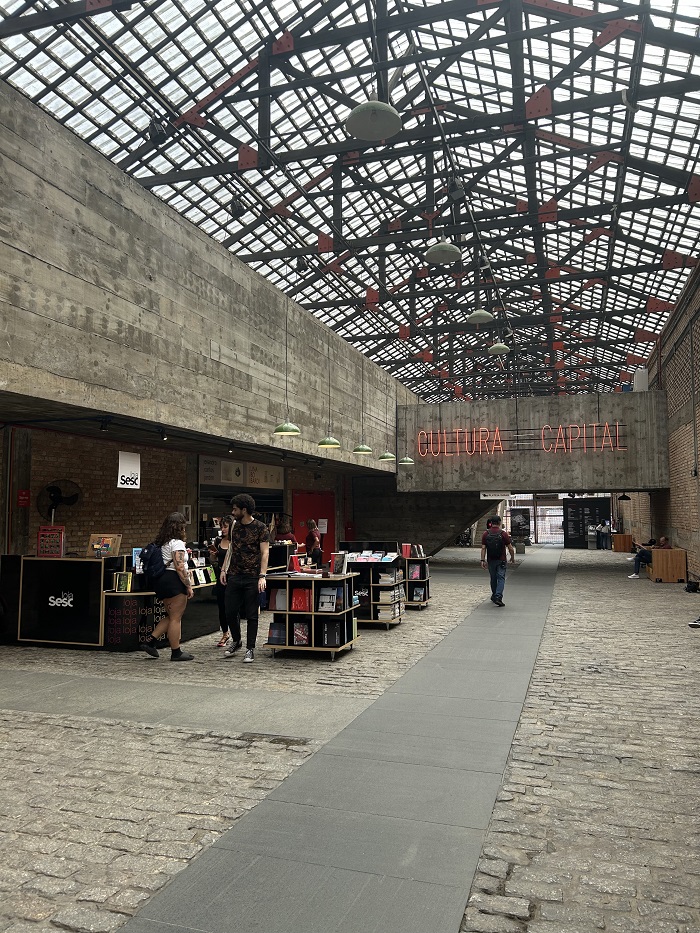Written by Martha Denton, (University of Minnesota), Student Correspondent for CET Brazil, (USP track), Fall 2024
When you think of Brazil, the first thing that comes to mind is likely beaches, palm trees, and maybe the Christ the Redeemer statue. For many Americans, Rio de Janeiro is cemented in our imagination as the prototypical image of Brazil. In early September, I had a chance to visit Rio, known as the Cidade Maravilhosa, during a week off of classes.
While I enjoyed my visit, I couldn’t help but feel grateful to call São Paulo home for the semester on the bus ride back. Since São Paulo so far has not been given a blockbuster animated movie like Rio, I wanted to give it some well-deserved airtime. Maybe I’ve absorbed some of the São Paulo vs. Rio rivalry that’s present in southeastern Brazil. I genuinely think São Paulo is a nicer place to live, and importantly: better situated to help you learn Brazilian Portuguese. Here are five reasons why I think São Paulo is a better place to study Portuguese than Rio!
1. Escape the tourists
In my two months of living here, I have seen a total of one kitschy souvenir shop. That’s not to say people don’t travel to São Paulo. But travel is primarily for business, and often from within Latin America. Beyond the obvious advantages of having fewer tourist traps trying to coerce you into buying sunglasses or overpriced açaí, it’s great for linguistic immersion.
While in Rio many shopkeepers speak English because of the tourist industry, it’s relatively uncommon for Paulistanos to speak English. This is the perfect scenario for language acquisition. In general, don’t come to Brazil expecting to speak English. Only about 5% of the population speaks it. This environment pushes you to learn the vocabulary to do simple things like order a sonho (cream donut) at a padaria (bakery) or more complicated things like making a friend in a university class. Studying in a non-touristy city also gives you a perspective of Brazilian life that is not crafted for a tourist gaze. For example, its many cultural institutions created for locals to enjoy, not for tourist ticket revenue.
2. Access incredible cultural institutions
As the largest Portuguese-speaking city in the world, São Paulo has some of the best museums and festivals in Latin America. As part of my pre-semester Portuguese intensive, I had the opportunity to visit four museums and write about what I learned. One of my favorites was the Museu da Língua Portuguesa (Museum of the Portuguese Language) where I learned about the influence of Indigenous languages like Tupi-Guarani and African languages like Quimbundo on modern Portuguese.
A visit to the Museu de Futebol (Soccer Museum) made me reflect on the way Brazilian soccer stars like Pelé and Neymar have been used to uphold the myth of racial democracy in Brazil. At the Pinacoteca, I saw the famous painting “Antropofagia” that symbolizes the search for a unified Brazilian identity by celebrated artist Tarsila do Amaral. And finally at the MASP (Art Museum of São Paulo) I got to appreciate the painting “Os Retirantes” by Candido Portinari depicting migration from Northeastern Brazil. Museums are one of my favorite ways to learn the language and culture of a place, and São Paulo does not disappoint.


In addition to museums, São Paulo attracts international festivals like the Bienal Internacional do Livro de São Paulo (International Book Biennial of São Paulo) where I got to listen to a discussion with Brazilian writers Carla Madeira and Eliana Alves Cruz. I’m also excited to attend the Mostra Internacional de Cinema de São Paulo (São Paulo International Film Festival) in October. Having the largest population of any metropolitan area in both the southern and western hemispheres means there are always interesting festivals, events, and concerts to attend to immerse yourself in the language.
3. Listen to a more comprehensible dialect
São Paulo gets another point (not that anyone’s keeping score) for having a dialect that is generally easier for English-speakers to understand. Cariocas (people from Rio) often pronounce their s’s as “sh”, similar to European Portuguese. If you’re a linguist, that means post-vocalic -s is usually pronounced [ʃ] or [ʒ] instead of [s] or [z]. Carioca R’s are also more guttural, sort of like Parisian French. Neither accent is more “correct,” but Paulistanês (Paulistano Portuguese) is typically easier to understand for people whose native language is English. Since São Paulo is home to migrants from ever state of the country and beyond, you’ll also be exposed to a variety of accents in your day-to-day life.
4. Enjoy the livability of São Paulo’s urban infrastructure
I would argue that there’s often a difference between a place that’s nice to live and a place that’s nice to visit. I won’t try to convince you that São Paulo can compete with Rio in terms of natural beauty. Rio’s enormous urban forests and ocean views are stunning. But what São Paulo lacks in postcard views, it makes up for in its livability, for example its better transportation, cleaner streets, and lower crime rates. And it’s not like São Paulo is without natural beauty, I live a 10-minute walk from Parque da Água Branca, a huge park complete with an outdoor zoo, an aquarium, a huge event space with weekly markets, and trails that are great for running and walking.


Another perk is that the São Paulo area as 25 Sesc locations (Serviço Social do Comércio), a non-profit organization with community centers throughout Brazil that has the goal of improving quality of life for workers and families. I recently spent the better part of a Saturday at Sesc Pompeia. In the same visit I saw three short films, studied at the library, walked around and admired the architecture, saw a play, bought a shirt, and ate two delicious meals (both under $R 25 ~ USD $4.60). And that’s only a fraction of what they offer, this Sesc also has a swimming pool, art studio, and dental clinic.
5. Take advantage of travel opportunities

Now that I’ve spent several paragraphs disparaging Rio, I need to emphasize that it is a very lovely city to visit. I especially liked taking a cable car up to see the views from Pão de Açúcar mountain, going to a samba night at Pedra do Sal, and visiting the Biblioteca Nacional. And luckily, if you’re studying in São Paulo, you’re only a six hours bus ride or one hour flight away, so it’s easy to go for a long weekend. São Paulo is a transport hub, with thousands of inter-city buses leaving every day and the largest airport in the country. If you want to travel, you have relatively easy access to other important cities like Curitiba, Belo Horizonte, Florianópolis, and São Paulo’s nearest beach town Santos.
Even though São Paulo doesn’t play much of a role in the American popular imagination (yet), it’s a city with unending places to explore and a great environment for learning Portuguese. While it’s not a perfect analogy, I once heard São Paulo referred to as the New York of Brazil and Rio as Miami. But no matter where you decide to study, you’ll gain a unique perspective on Brazilian culture and the Portuguese language.
Source link
All Materials on this website/blog are only for Learning & Educational purposes. It is strictly recommended to buy the products from the original owner/publisher of these products. Our intention is not to infringe any copyright policy. If you are the copyright holder of any of the content uploaded on this site and don’t want it to be here. Instead of taking any other action, please contact us. Your complaint would be honored, and the highlighted content will be removed instantly.
